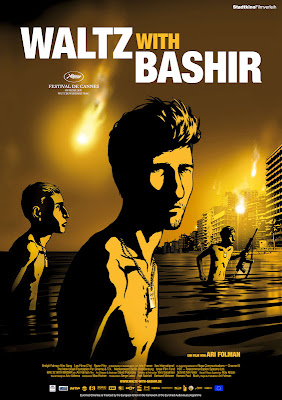This review will be critically analysing animated documentary movie "Waltz with Bashir" directed by Ari Folman. It is a very graphically shown story concentrated on real massacre that happened in 1982 during the Israel's invasion of Lebanon. This review is based on Roger Ebert's, Peter Travers' and Andrew O'Heir's reviews.
Figure 1
This movie is probably done in the most appropriate way and movie critics like Roger Ebert and Peter Travers just approves that. Roger Ebert Says: "Now he uses it as the best way to reconstruct memories, fantasies, hallucinations, possibilities, past and present. This film would be nearly impossible to make any other way." (Chicago Sun Times, January 21, 2009). The whole documentary is built on vague memories connected with real facts. The interviewed people had very objective opinions, because they were in this thing helping for bad things to happen, they knew it and their memories were as valuable as that tiny bit of live action footage which was left.
Figure 2
Peter Travers gives us clear reason why the director chose to use animation instead of live action footage: "Folman took a graphic-novel approach because, in his words, "animation functions on the border between reality and the subconscious."" (Rolling Stone reviews, January 22, 2009). It brings back again just like in the most of other reviews this discussion about dreams and hallucinations through animation. It seems that these things can not be separated just because they are just too close to each other. Animation is literately a window to our dream and fantasy worlds, but our dreams sometimes can be about the real world and serious sometimes almost like this documentary.
Figure 3
Andrew O'Heir gives us even better reason of making this documentary in the way that it was done from his interview with Aru Folman himself: "As a filmmaker it gave me total freedom to do whatever I liked. To go from one dimension to another. To go from real stories to the subconscious to dreams to hallucinations to drugs to fear of death to anxiety, everything. I had the liberty to play with everything in one story line." (Salon Reviews, December 26, 2008). Animation really gives this freedom for the directors to do whatever they like, so it is all about the content and purpose. Nice and dynamic change in the end to the live action footage brings the audience back to reality and shows that those memories even though they might be not 100 percent accurate are real and those terrible things have actually happened.
All in all this is truly deep and interesting documentary. It might be one of the best documentaries ever made, because of its originality and absolutely stunning presentation. It is touching and educating just as it should be.
Bibliography:
1) Roger Ebert (Chicago Sun Times, January 21, 2009): http://rogerebert.suntimes.com/apps/pbcs.dll/article?AID=/20090121/REVIEWS/901219995/1023
2) Peter Travers (Rolling Stone reviews, January 22, 2009):
3) Andrew O'Heir (Salon Reviews, December 26, 2008):
Illustrations:
1) Main character http://www.channel4.com/programmes/waltz-with-bashir
2) Illusion http://www.filmschoolrejects.com/reviews/foreign-objects-waltz-with-bashir-vals-im-bashir.php




No comments:
Post a Comment